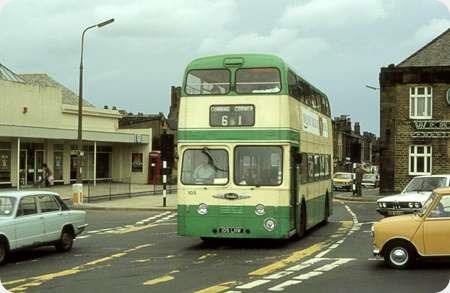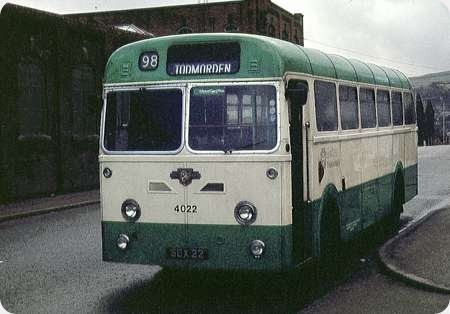West Yorkshire PTE - Daimler Fleetline - 105 LNW - 105
West Yorkshire PTE (Calderdale District)
1964
Daimler Fleetline CRG6
Roe H41/29F
New to Leeds City Transport, 105 (105 LNW) was one of ten (101-110) Daimler Fleetline CRG6’s with Roe
H41/29F bodies delivered in late 1964, 101 differing from the rest in having a curved windscreen and
having been exhibited at the Commercial Motor Show in the October.
Having passed to the Leeds
District of the West Yorkshire PTE on 1st April 1974, 101-105 were transferred to the Calderdale
District at Halifax in June 1979.
The Roe metal-framed bodies on Fleetlines and Atlanteans of this
era were to Park Royal design, and many gained a poor reputation for body corrosion and weakness, but
these always seemed to me at least to be very solidly built and rattle free, though they had the usual
early Fleetline features of heavy steering and unpredictable brakes. 101’s heating and demisting system
did not work at all though and during the winter of 1979 it would become freezing cold and was rarely
out on the road for more than an hour or so before the windscreen would frost over both outside and in
and be rung in for a changeover. It was also very slow and apparently troublesome in other ways and was
consequently withdrawn fairly quickly. The other four with their flat fronts were quite decent buses
though and carried on a while longer.
By February 1981 all but 105 had gone, but it remained,
doggedly slogging on and outlasting the others by twenty months before being sold at Central Motor
Auctions to Rollinson’s, the Barnsley breaker in September 1982.
Here it is seen in 1981 passing
through King Cross en route for Cunning Corner.
Photograph and Copy contributed by John Stringer
19/01/17 - 07:17
John, Derby Corporation took their first Fleetlines in 1966 with Roe bodies
virtually identical to these of Leeds. Now Derby were known for getting long service out of their
buses, twenty years was the norm and that included some of the utilities. With the Fleetlines the
service life was reduced to fourteen years and some only managed twelve. Like you say, they seemed
to be substantially built and I’ve often wondered if there was a change of policy or if there was
some inherent weakness which wasn’t readily apparent.
Derby’s neighbour, Trent, had some Roe
bodied Atlanteans with the squarer type of Roe body as supplied to Hull, Sheffield and some NGT
companies and although I liked them, the quality always seemed inferior to the one seen above.
Chris Barker
20/01/17 - 06:37
Chris, at NGT Percy Main depot (Tynemouth & District the Roe bodied Atlantean’s you refer to were known as ‘flat tops’.
Ronnie Hoye
20/01/17 - 06:38
Curiously, John, the driving turns I undertook on the 62 route (as it then was in 1964-66) terminated at Rishworth, and I never managed to drive a bus the short distance onward to Cunning Corner or Commons. On the subject of the Roe bodies to Park Royal design, I would suspect that the preparation and treatment of the framing at the Roe factory was somewhat superior to that applied at Park Royal, with consequent benefits in corrosion protection. On a parallel matter, I have just obtained and read my copy of "Steel Wheels and Rubber Tyres, Vol 3" by Geoffrey Hilditch, and his account of life under the West Yorkshire PTE is highly revealing. The reckless profligacy and dearth of cost/revenue management information compares with London Transport at its worst. It would seem that those deemed to be "in charge" proceeded on the principle that the government would not allow its pet PTA/PTE transport policies to fail, so "Spend, spend, spend". Yes, the author’s view might be coloured because GGH himself was not enamoured of the PTE setup, and had been caught up in its entrails by accident rather than design, but the fact remains that West Yorkshire PTE became technically insolvent for some time.
Roger Cox
Quick links to the - Comments Page - Contact Page - Home Page


